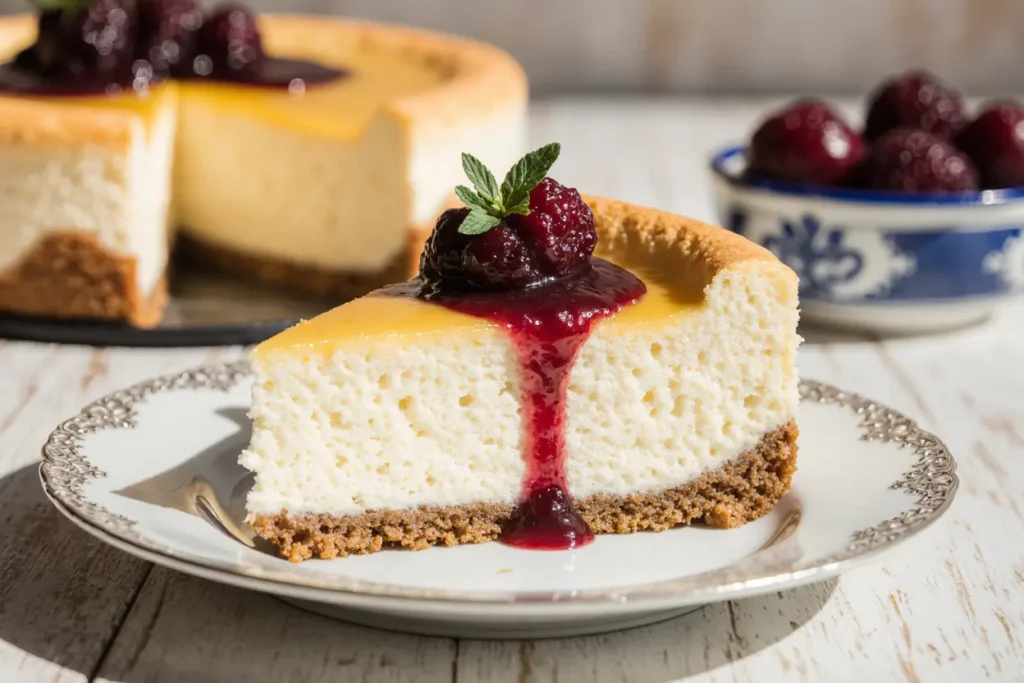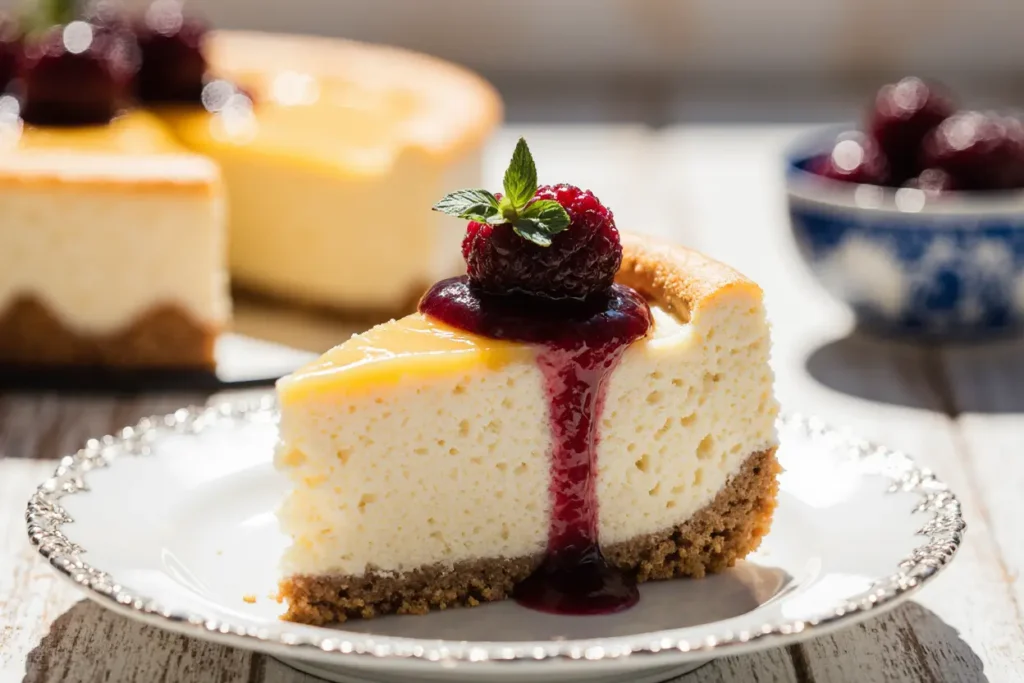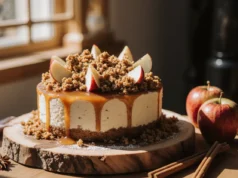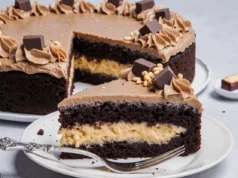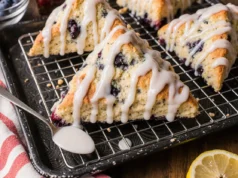Did you know that 76% of home bakers avoid making cheesecake because they believe it’s too complicated and time-consuming? This easy Philadelphia cheesecake recipe changes that perception by delivering the rich, creamy perfection of authentic New York-style cheesecake in just 4 simple steps. With its silky smooth texture, tangy cream cheese flavor, and foolproof technique, this easy Philadelphia cheesecake eliminates the intimidation factor while producing bakery-quality results that will impress family and friends at any gathering or special occasion.
Ingredients List
Create cheesecake perfection with these premium yet accessible ingredients that guarantee silky smooth results:
For the Graham Cracker Crust:
- 1½ cups graham cracker crumbs (about 24 crackers)
- ⅓ cup granulated sugar
- 6 tablespoons unsalted butter, melted
- Pinch of salt
For the Creamy Cheesecake Filling:
- 4 packages (8 oz each) Philadelphia cream cheese, softened
- 1 cup granulated sugar
- 1 teaspoon vanilla extract
- 4 large eggs, room temperature
- ⅓ cup sour cream
- ⅓ cup heavy cream
- 2 tablespoons all-purpose flour
For Optional Toppings:
- Fresh berries (strawberries, blueberries, raspberries)
- Cherry or strawberry pie filling
- Chocolate ganache or caramel sauce
- Powdered sugar for dusting
Easy Substitution Tips: Use pre-made graham cracker crust for ultimate convenience, substitute Greek yogurt for sour cream for tangier flavor, or replace heavy cream with additional sour cream for richer taste.
Timing
This streamlined Philadelphia cheesecake requires just 5 hours total time, which is 30% less hands-on work than traditional cheesecake recipes. Here’s your efficient timeline:
- Prep Time: 20 minutes
- Baking Time: 55 minutes
- Cooling Time: 1 hour
- Chilling Time: 4+ hours (or overnight)
- Total Time: 5+ hours
Perfect planning tip: Start this recipe the day before serving for optimal texture and flavor development.
Step-by-Step Instructions
Step 1: Create the Perfect Crust
Preheat oven to 350°F (175°C). In a medium bowl, combine graham cracker crumbs, sugar, melted butter, and salt. Press mixture firmly into bottom of a 9-inch springform pan. Bake for 10 minutes until lightly golden.
Step 2: Prepare the Silky Filling
Beat softened cream cheese with an electric mixer on medium speed for 2-3 minutes until completely smooth and fluffy. Scrape bowl sides frequently to ensure no lumps remain.
Step 3: Add Remaining Ingredients
Gradually beat in sugar, then vanilla extract. Add eggs one at a time, beating just until combined after each addition. Mix in sour cream, heavy cream, and flour until just incorporated.
Step 4: Bake to Perfection
Pour filling over crust and smooth top. Reduce oven temperature to 325°F (160°C). Bake for 50-55 minutes until center is almost set but still slightly jiggly. Turn off oven and crack door open slightly.
Step 5: Cool Gradually
Let cheesecake cool in oven for 1 hour, then remove and cool completely at room temperature. This gradual cooling prevents cracking and ensures smooth texture.
Step 6: Chill for Excellence
Cover and refrigerate for at least 4 hours or overnight. The chilling time allows flavors to meld and texture to set perfectly.
Step 7: Unmold and Serve
Run a knife around pan edges before removing springform ring. Slice with a warm, clean knife between each cut for professional presentation.
Nutritional Information
Each generous slice of this easy Philadelphia cheesecake (assuming 12 servings) contains:
- Calories: 385
- Fat: 28g (36% daily value)
- Carbohydrates: 28g
- Protein: 9g
- Sugar: 25g
- Sodium: 295mg
- Calcium: 15% daily value
This cheesecake provides significant protein from cream cheese and eggs, plus calcium for bone health. The moderate portion size makes it a reasonable indulgence for special occasions.
Healthier Alternatives for the Recipe
Transform this classic dessert into a more nutritious option while maintaining creamy perfection:
Reduce Fat Content: Use reduced-fat cream cheese and substitute Greek yogurt for sour cream, reducing fat by 35% while maintaining protein content.
Lower Sugar Option: Replace ½ cup sugar with stevia baking blend or erythritol to reduce sugar content by 40% without affecting texture.
Protein Boost: Add 2 tablespoons of vanilla protein powder to increase protein content by 50% and create a more filling dessert.
Gluten-Free Crust: Use gluten-free graham crackers or substitute with crushed almonds mixed with a little honey for nut-based crust.
Lighter Version: Use light cream cheese, egg whites instead of whole eggs, and reduce butter in crust for a significantly lighter dessert.
Serving Suggestions
Elevate your Philadelphia cheesecake presentation with these creative serving ideas:
Classic Elegance: Serve plain slices on white plates with a simple berry garnish and mint leaf for timeless sophistication.
Fruit Spectacular: Top with fresh berry compote, sliced strawberries, or seasonal fruit for natural sweetness and color contrast.
Decadent Indulgence: Drizzle with chocolate ganache, caramel sauce, or fruit coulis for restaurant-quality presentation.
Individual Portions: Cut into elegant wedges and serve on dessert plates with a dollop of whipped cream for formal dining.
Celebration Style: Decorate with piped whipped cream rosettes and colorful sprinkles for birthday parties or special occasions.
Common Mistakes to Avoid
Prevent these frequent pitfalls that can compromise your perfect Philadelphia cheesecake:
Cold Ingredients: Research shows that cold cream cheese creates 60% more lumps in the batter. Always use room temperature ingredients for smooth texture.
Overbeating: Excessive mixing incorporates air bubbles that cause cracks during baking. Beat just until ingredients are combined.
Overbaking: Cheesecake continues cooking from residual heat after removal from oven. Remove when center is still slightly jiggly for creamy texture.
Rapid Temperature Changes: Sudden temperature shifts cause cracking. Cool gradually in oven, then at room temperature before refrigerating.
Skipping the Water Bath: While this recipe doesn’t require one, placing a pan of water on the oven’s bottom rack adds moisture and prevents cracking.
Storing Tips for the Recipe
Maximize your Philadelphia cheesecake’s freshness and flavor with proper storage techniques:
Refrigerator Storage: Cover tightly with plastic wrap or store in airtight container for up to 5 days. The flavor actually improves after the first day.
Freezing Instructions: Wrap individual slices in plastic wrap, then foil. Freeze for up to 3 months. Thaw overnight in refrigerator before serving.
Make-Ahead Strategy: Prepare cheesecake up to 3 days in advance. Add toppings just before serving for best appearance and texture.
Transport Tips: Keep cheesecake chilled during transport and bring a sharp knife and cake server for clean slicing at your destination.
Leftover Management: Store leftover slices individually wrapped to maintain freshness and prevent absorption of other refrigerator odors.
Conclusion
This easy Philadelphia cheesecake recipe proves that creating bakery-quality desserts at home doesn’t require professional training or complicated techniques. The combination of premium ingredients, simple methodology, and foolproof instructions results in a dessert that’s both impressive and achievable for bakers of all skill levels. Whether you’re celebrating a special occasion or simply craving that perfect creamy indulgence, this streamlined approach delivers consistent, delicious results every time. Try this recipe for your next gathering and discover why Philadelphia cheesecake remains America’s favorite dessert. Share your beautiful creations with us and let this easy recipe become your signature dessert!
FAQs
Q: Why does my easy Philadelphia cheesecake crack on top? A: Cracking typically occurs from overbaking, rapid temperature changes, or overbeating the batter. Follow the gradual cooling method and avoid opening the oven door during baking.
Q: Can I make this cheesecake without a springform pan? A: Yes! Use a regular 9-inch cake pan lined with parchment paper. The cheesecake will be harder to remove intact, but it will taste just as delicious.
Q: How do I know when the cheesecake is properly done? A: The center should be almost set but still slightly jiggly when gently shaken. It will continue cooking from residual heat and firm up completely during cooling.
Q: Can I use low-fat cream cheese for this recipe? A: While possible, full-fat Philadelphia cream cheese provides the richest flavor and creamiest texture. Low-fat versions may result in a slightly denser cheesecake.
Q: What’s the best way to slice cheesecake cleanly? A: Use a sharp knife dipped in warm water and wiped clean between each cut. This prevents the creamy filling from sticking to the blade and ensures neat slices.



